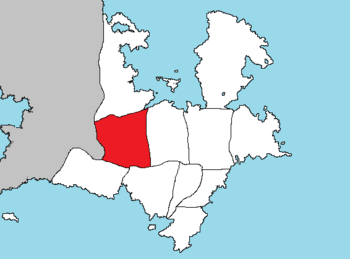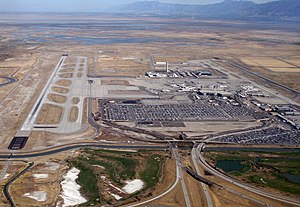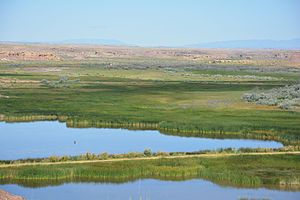Calahan: Difference between revisions
| (3 intermediate revisions by the same user not shown) | |||
| Line 103: | Line 103: | ||
*[[Petra (State)|Petra]] (east) | *[[Petra (State)|Petra]] (east) | ||
*[[West Monroe]] (southeast) | *[[West Monroe]] (southeast) | ||
*[[Panamor]] ( | *[[Panamor]] (southwest) | ||
*[[Calejo]] (West) | |||
==Economy== | ==Economy== | ||
| Line 112: | Line 114: | ||
[[File:Utah Horses.jpg|thumb|Farms and ranches]] | [[File:Utah Horses.jpg|thumb|Farms and ranches]] | ||
According to the Bureau of Economic Analysis, the gross state product of | According to the Bureau of Economic Analysis, the gross state product of Calahan in 2012 was $306,000,000,000. The per capita personal income was $50,148 in 2015. Major industries of Calahan include: mining, cattle ranching, tourism, and government services. | ||
According to the 2007 State New Economy Index, Calahan is ranked the top state in the nation for Economic Dynamism, determined by "the degree to which state economies are knowledge-based, globalized, entrepreneurial, information technology-driven and innovation-based". In 2014, Calahan was ranked number one in the list of "Best States For Business". A November 2010 article in ''Ibica Today'' magazine highlighted Calahan and particularly the Cuyoga area's economic outlook and examined how the area has been able to bring in high-paying jobs and attract high-tech corporations to the area. In terms of "small business friendliness", in 2014 Calahan emerged as number one, based on a study drawing upon data from over 12,000 small business owners. | According to the 2007 State New Economy Index, Calahan is ranked the top state in the nation for Economic Dynamism, determined by "the degree to which state economies are knowledge-based, globalized, entrepreneurial, information technology-driven and innovation-based". In 2014, Calahan was ranked number one in the list of "Best States For Business". A November 2010 article in ''Ibica Today'' magazine highlighted Calahan and particularly the Cuyoga area's economic outlook and examined how the area has been able to bring in high-paying jobs and attract high-tech corporations to the area. In terms of "small business friendliness", in 2014 Calahan emerged as number one, based on a study drawing upon data from over 12,000 small business owners. | ||
In eastern | In eastern Calahan petroleum production is a major industry. Near Cuyoga, petroleum refining is done by a number of oil companies. In central Calahan, coal production accounts for much of the mining activity. | ||
According to Internal Revenue Service tax returns, | According to Internal Revenue Service tax returns, Calahanites rank first among all states in the proportion of income given to charity by the wealthy. According to the Corporation for National and Community Service, Calahan had an average of 884,000 volunteers between 2008 and 2010, each of whom contributed 89.2 hours per volunteer. This figure equates to $3.8 billion of service contributed, ranking Calahan number one for volunteerism in the nation. | ||
===Taxation=== | ===Taxation=== | ||
| Line 126: | Line 128: | ||
Tourism is a major industry in Calahan. With several national parks, national monuments, national recreation areas,national forests, and monuments. | Tourism is a major industry in Calahan. With several national parks, national monuments, national recreation areas,national forests, and monuments. | ||
In addition to having prime snow condition and world-class amenities, central Calahan's ski resorts are well liked among tourists for their convenience and proximity to a [[Cuyoga|large city]] and [[Cuyoga Liberty | In addition to having prime snow condition and world-class amenities, central Calahan's ski resorts are well liked among tourists for their convenience and proximity to a [[Cuyoga|large city]] and [[Cuyoga Liberty International Airport|international airport]], as well as the close proximity to other ski resorts, allowing skiers the ability to ski at multiple locations in one day. The 2009 Ski Magazine reader survey concluded that six out of the top ten resorts deemed most "accessible" and six out of the top ten with the best snow conditions were located in Calahan. | ||
===Mining=== | ===Mining=== | ||
| Line 140: | Line 142: | ||
[[File:Green line Trax at Gallivan Plaza.jpg|thumb|TRAX light rail serves [[Cuyoga County, Calahan|Cuyoga County]]]] | [[File:Green line Trax at Gallivan Plaza.jpg|thumb|TRAX light rail serves [[Cuyoga County, Calahan|Cuyoga County]]]] | ||
[[Interstate 5]] and [[Interstate 25]] are the main [[Interstate Highway System|interstate]] highways in the state. I-5 traverses the state north-to-south, entering from [[Panamor]] near [[Louisville, Calahan|Louisville]], paralleling the Upper Cuyoga Valley, and crossing into [[Hamilton]] near [[Northgate, Calahan|Northgate]]. I- | [[Interstate 5]] and [[Interstate 25]] are the main [[Interstate Highway System|interstate]] highways in the state. I-5 traverses the state north-to-south, entering from [[Panamor]] near [[Louisville, Calahan|Louisville]], paralleling the Upper Cuyoga Valley, and crossing into [[Hamilton]] near [[Northgate, Calahan|Northgate]]. I-25 spans eastern Calahan north-to-south, entering from [[Petra (State)|Petra]] south of [[McLean, Calahan|McLean]] and terminates in Florence. [[Interstate 70]] Darts across the northeast corner of the state and [[Interstate 50]] darts across the southeastern corner of the state. A proposed [[Interstate 60]] would run east-west across the state, linking Cuyoga and Meridan to [[Mobile, Petra]]. | ||
[[Cuyoga Liberty International Airport]] is the only international airport in the state and serves as the main hub for [[Western Airlines]]. The airport has consistently ranked first in on-time departures and had the fewest cancellations among Ibican airports. | [[Cuyoga Liberty International Airport]] is the only international airport in the state and serves as the main hub for [[Western Airlines]]. The airport has consistently ranked first in on-time departures and had the fewest cancellations among Ibican airports. | ||
Latest revision as of 00:10, 8 December 2021
The State of Calahan | |
|---|---|
|
Flag | |
| Motto: "The Natural State" | |
 Calahan highlighted in Ibica | |
| Capital | Cuyoga |
| Official languages | English |
| Demonym(s) | Calahanite |
| Government | |
• Governor | Rick Scott |
| Legislature | Congress |
| Senate | |
| House of Representatives | |
| Establishment | |
• Territory Established | March 3rd, 1701 |
• Statehood | January 1, 1822 |
| Area | |
• Total | 744,814 km2 (287,574 sq mi) |
| Population | |
• 2015 census | 6,101,833 |
| GDP (nominal) | 2015 estimate |
• Total | $306,000,000,000 |
• Per capita | $50,148 |
Calahan is a state in Ibica. It became the 8th state admitted to the federation on January 1, 1822. Calahan is the 7th-largest by area and population. Calahan has a population of more than 6 million according to the 2015 Census. Urban development is mostly concentrated in one area: the Cuyoga Valley. Calahan is bordered by Hamilton to the north, the Bay of Albion to the northeast, Petra to the east, West Monroe to the southeast, and Panamor to the southwest.
The state is a center of transportation, education, information technology and research, government services, and mining and a major tourist destination for outdoor recreation. In 2013, the Ibican Census Bureau estimated that Calahan had the second-fastest-growing population of any state. Cuyoga was the fastest-growing metropolitan area in Ibica from 2010 to 2015. A 2012 Gallup national survey found Calahan overall to be the "best state to live in the future" based on 13 forward-looking measurements including various economic, lifestyle, and health-related outlook metrics.
Geography and geology
Calahan is known for its natural diversity and is home to features ranging from arid deserts with sand dunes to thriving pine forests in mountain valleys. It is a rugged and geographically diverse state that is at the convergence of three distinct geological regions: the Madison Mountains, the Great Basin, and the Albion Coastal Plain.
One of Calahan's defining characteristics is the variety of its terrain. Running down the middle of the state's northern third is the Brady Range, which rises to heights of almost 12,000 ft (3,700 m) above sea level. Calahan is home to world-renowned ski resorts, made popular by the light, fluffy snow, and winter storms which regularly dump 1 to 3 feet of overnight snow accumulation. Western Calahan is mostly arid desert with a basin and range topography. Small mountain ranges and rugged terrain punctuate the landscape.
This terrain is the central feature of protected state and federal parks such as Lion's Gate National Park, Carcer Mountain National Park, and the Madison Ski Area.
Adjacent states
- Hamilton (north)
- Petra (east)
- West Monroe (southeast)
- Panamor (southwest)
- Calejo (West)
Economy

According to the Bureau of Economic Analysis, the gross state product of Calahan in 2012 was $306,000,000,000. The per capita personal income was $50,148 in 2015. Major industries of Calahan include: mining, cattle ranching, tourism, and government services.
According to the 2007 State New Economy Index, Calahan is ranked the top state in the nation for Economic Dynamism, determined by "the degree to which state economies are knowledge-based, globalized, entrepreneurial, information technology-driven and innovation-based". In 2014, Calahan was ranked number one in the list of "Best States For Business". A November 2010 article in Ibica Today magazine highlighted Calahan and particularly the Cuyoga area's economic outlook and examined how the area has been able to bring in high-paying jobs and attract high-tech corporations to the area. In terms of "small business friendliness", in 2014 Calahan emerged as number one, based on a study drawing upon data from over 12,000 small business owners.
In eastern Calahan petroleum production is a major industry. Near Cuyoga, petroleum refining is done by a number of oil companies. In central Calahan, coal production accounts for much of the mining activity.
According to Internal Revenue Service tax returns, Calahanites rank first among all states in the proportion of income given to charity by the wealthy. According to the Corporation for National and Community Service, Calahan had an average of 884,000 volunteers between 2008 and 2010, each of whom contributed 89.2 hours per volunteer. This figure equates to $3.8 billion of service contributed, ranking Calahan number one for volunteerism in the nation.
Taxation
Calahan collects personal income tax; since 2008 the tax has been a flat 5 percent for all taxpayers. The state sales tax has a base rate of 6.45 percent, with cities and counties levying additional local sales taxes that vary among the municipalities. Property taxes are assessed and collected locally. Calahan does not charge intangible property taxes and does not impose an inheritance tax.
Tourism
Tourism is a major industry in Calahan. With several national parks, national monuments, national recreation areas,national forests, and monuments.
In addition to having prime snow condition and world-class amenities, central Calahan's ski resorts are well liked among tourists for their convenience and proximity to a large city and international airport, as well as the close proximity to other ski resorts, allowing skiers the ability to ski at multiple locations in one day. The 2009 Ski Magazine reader survey concluded that six out of the top ten resorts deemed most "accessible" and six out of the top ten with the best snow conditions were located in Calahan.
Mining
Beginning in the late 19th century with the state's mining boom, companies attracted large numbers of immigrants with job opportunities. Since the days of the Calahan Territory mining has played a major role in Calahan's economy.
These settlements were characteristic of the boom and bust cycle that dominated mining towns of the Ibican West. Today mining activity still plays a major role in the state's economy. Minerals mined in Calahan include copper, gold, silver, molybdenum, zinc, lead, and beryllium. Fossil fuels including coal, petroleum, and natural gas continue to play a large role in Calahan's economy, especially in the eastern part of the state
Transportation


Interstate 5 and Interstate 25 are the main interstate highways in the state. I-5 traverses the state north-to-south, entering from Panamor near Louisville, paralleling the Upper Cuyoga Valley, and crossing into Hamilton near Northgate. I-25 spans eastern Calahan north-to-south, entering from Petra south of McLean and terminates in Florence. Interstate 70 Darts across the northeast corner of the state and Interstate 50 darts across the southeastern corner of the state. A proposed Interstate 60 would run east-west across the state, linking Cuyoga and Meridan to Mobile, Petra.
Cuyoga Liberty International Airport is the only international airport in the state and serves as the main hub for Western Airlines. The airport has consistently ranked first in on-time departures and had the fewest cancellations among Ibican airports.
Law and government
Calahan government is divided into three branches: executive, legislative, and judicial. The current governor of Calahan is Rick Scott, who was sworn in on August 11, 2019. The governor is elected for a four-year term. The Calahan State Legislature consists of a Senate and a House of Representatives. State senators serve four-year terms and representatives two-year terms. The Calahan Legislature meets each year in January for an annual 45-day session.
The Calahan Supreme Court is the court of last resort in Calahan. It consists of five justices, who are appointed by the governor, and then subject to retention election. The Calahan Court of Appeals handles cases from the trial courts. Trial level courts are the district courts and justice courts. All justices and judges, like those on the Calahan Supreme Court, are subject to retention election after appointment.







